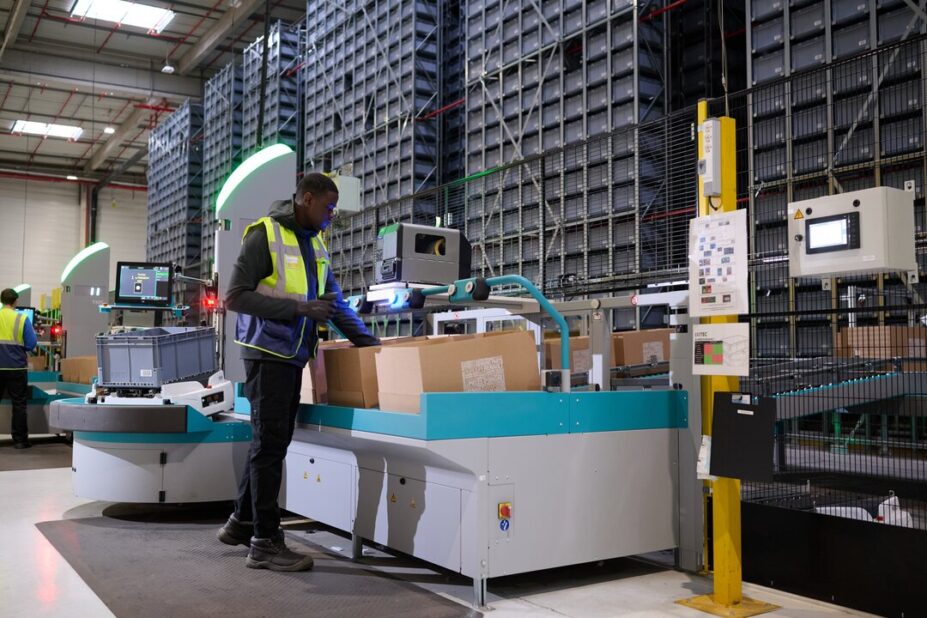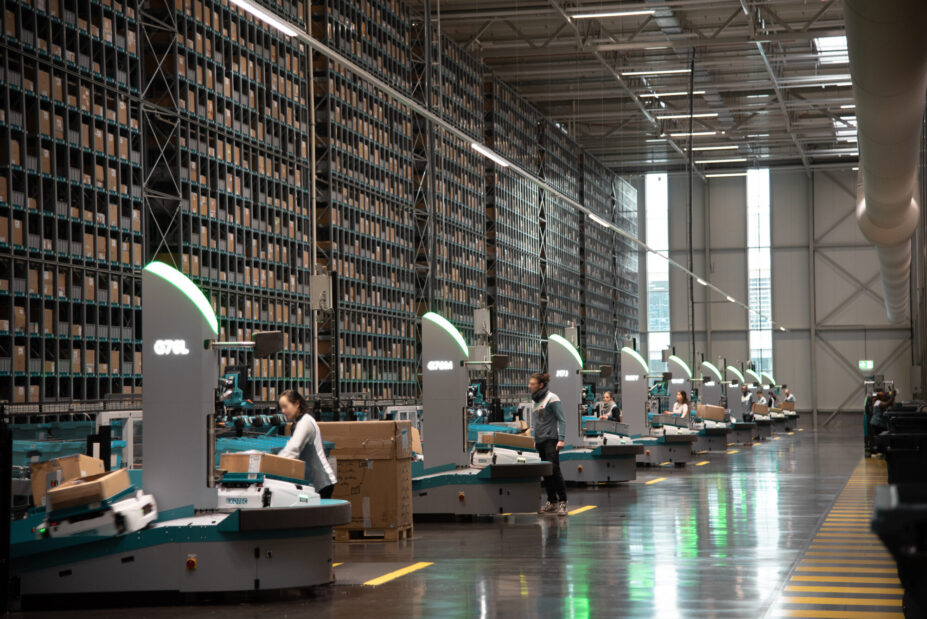
Connect with Clayton Everhart on LinkedIn
This article is part of our SME Corner, offering insights from our subject matter experts to guide you on your warehouse automation journey.
Automated storage and retrieval systems (ASRS) have become a crucial part of modern supply chains, boosting efficiency and accuracy while enabling businesses to move labor to higher value tasks. However, successful implementation requires careful planning, strategic alignment, and meticulous execution.
In this article, we’ll share essential steps and best practices for implementing ASRS in your warehouse. We’ll cover everything from understanding your business case and aligning with company strategy to defining success criteria and avoiding scope creep. Read on for insights on how to navigate the complexities of warehouse automation and achieve the best results.

Establish a Clear Direction
To effectively work with ASRS solution providers and design a system that best meets your needs, it’s essential to ensure internal alignment with key stakeholders before exploring solution options. Here are the critical areas your business should align on from the outset:
Understand Your Business Case: This involves delving into the reasons behind implementing warehouse automation. It’s crucial to assess the business case for the project, which may include factors like improving operational efficiency, reducing costs, enhancing accuracy, or meeting peak season demand more effectively. By understanding these drivers, you can pick the right ASRS solution to address your specific needs.
Align with Company Strategy: Warehouse automation initiatives should align with the broader strategic goals and objectives of your business. For example, if your company’s strategy is focused on rapid expansion, the automation solution should support scalability. On the other hand, if the goal is to add or expand a new channel, like e-commerce, your solution will likely require high throughput each picking capability.
Define Success Criteria: Success criteria should be clearly defined to measure the effectiveness of warehouse automation efforts. This involves establishing company metrics and key performance indicators (KPIs) related to factors like productivity, order accuracy, inventory turnover, and labor utilization. Setting specific targets and objectives ensures clarity of purpose and helps maintain focus during the solution design process.
Minimize Scope Creep and Change Orders: It’s not unlikely for automation projects to expand beyond their original scope, which leads to increased costs and delays. To mitigate this risk, it’s important to establish clear boundaries and specifications for the automation project from the outset. It’s essential to clarify the design parameters and assumptions underlying the project. This includes considerations like the types of products (SKUs), order profiles, and fulfillment channels that will be affected by automation. By defining these parameters upfront, you can reduce the risk of scope creep and ensure that the automation solution meets the specific needs of your business.

Gather the Appropriate Data & Information
A pivotal step in your warehouse automation journey is ensuring you have all the necessary data and information to share with solution providers. The goal here is to ensure that the automation provider has a clear understanding of your business’ needs, goals, and constraints, enabling the development of a tailored automation solution that meets your business’ requirements effectively. This is typically a challenge as it requires a high degree of strategic alignment, planning, and execution across various departments. Here’s our comprehensive guide to help you achieve success.
Warehouse Operations
Be prepared to share detailed insights into your current processes, workflows, and pain points within the warehouse. Clearly articulate the specific requirements and challenges that the ASRS needs to address, including the following:
Inventory Data:
- SKU information including numbers, descriptions, and attributes
- Current inventory levels and turnover rates for each SKU
- Packaging attributes including size, dimensions, and weight of packaging materials
Order Data:
- Order volume and frequency analysis, including peak periods and seasonal fluctuations
- Order profiles, such as order size (number of SKUs per order) and order types (e.g., single-line vs. multi-line orders)
- Order processing times, from order receipt to shipment
Process Data:
- Current warehouse layout and floor plan, including storage areas, aisles, and pick zones
- Process maps or flowcharts detailing current processes, workflows, and material handling activities
Performance Metrics:
- Key performance indicators (KPIs) related to warehouse operations, such as order accuracy, on-time delivery, and inventory accuracy
- Customer service metrics, including order fill rates and lead times
Information Technology
It is imperative to assess the compatibility of the automation solution with your existing technology infrastructure, including warehouse management systems (WMS), enterprise resource planning (ERP) systems, and network architecture. Additionally, evaluating security and data integration requirements is crucial to ensure seamless and secure operation. This includes:
Infrastructure Data:
- Detailed information about the existing IT infrastructure, including servers, networks, and data storage systems
- Specifications of hardware components such as servers, workstations, routers, switches, and other network devices
- Inventory of software applications and systems used in the warehouse, including versions, licenses, and dependencies
Integration Requirements:
- Data integration needs between the proposed solution and existing systems (e.g., WMS, ERP)
- API documentation and technical specifications for integrating with third-party software and hardware
- Data mapping and transformation requirements for transferring data between systems
Security Requirements:
- Security policies, protocols, and compliance standards that must be followed during the automation implementation
- Access control requirements for users and administrators of the ASRS system
- Encryption standards and data protection measures to safeguard sensitive information
Data Management:
- Data governance policies and procedures for managing and maintaining data integrity
- Data storage and retention requirements, including backup and archival strategies
- Data cleansing and normalization processes to ensure accuracy and consistency of data
Finance
Thoroughly evaluate the financial aspects of the automation project, including conducting a cost-benefit analysis and determining budget allocation and funding options. This ensures that the project aligns with your financial objectives and constraints, making it feasible and sustainable. This includes:
- Details of the allocated budget for the automation project, including capital expenditure (CapEx) and operational expenditure (OpEx) components
- Breakdown of budget categories, such as hardware, software, implementation services, training, and maintenance
Safety and Compliance
Be prepared to evaluate whether the proposed solution complies with your business’s safety regulations, industry standards, and internal policies. Be ready to share the following details with solution providers:
- Documentation of existing safety policies and procedures within the warehouse environment
- Overview of safety protocols related to equipment operation, material handling, and personnel safety
- Hazard identification and risk assessment reports for the warehouse facility

Choose the Right ASRS Solution
Once you’ve established a clear direction for implementing an ASRS and gathered the appropriate data and information it’s time to get into the fun of the automation selection process. Selecting the right ASRS for your warehouse operations involves a thorough understanding of both your current requirements and future objectives. The process of navigating through the myriad of solution providers can be daunting. To aid in this decision, consider these crucial functional factors when comparing solutions:
- Space Constraints: Evaluate the available space and how different ASRS configurations can optimize space utilization
- Budget: Determine the budgetary allowances, considering the upfront investment and long-term operational savings
- Integration Capabilities: Consider how seamlessly the ASRS system can integrate with existing warehouse management systems and operational workflows
- Scalability: Assess the scalability of the system to ensure it can grow in tandem with the evolving needs of the warehouse
- Sprinklage: Review the sprinklage requirements for each solution and consult with your local fire marshal and relevant laws to determine the necessary fire suppression infrastructure
- Support & Maintenance: Examine the level of support and maintenance services the vendor provides to ensure smooth operations post-implementation
Prepare Your Brownfield Facility
To implement the ASRS in a brownfield facility while maintaining order fulfillment, a comprehensive renovation plan is essential. While your solution provider can assist in developing this plan, the critical input must come from your internal teams. This plan should include the following key elements:
Dedicated Staging Area: Allocate a specific area for staging and assembling the new automation equipment. This ensures organized and efficient installation.
Clear Access Routes: Plan for unobstructed access routes to transport the equipment to its final location within the warehouse. This will facilitate smooth and safe movement of large and heavy components.
Temporary Storage Solutions: Ensure there is sufficient temporary storage space for current inventory and materials displaced during the renovation. This will help maintain order and prevent disruptions in operations.
Continuity Plan: Develop a detailed plan to continue operations during the renovation. This might involve alternative workflows to ensure that order fulfillment remains uninterrupted.

The Skypod System offers the optimal mix of performance and flexibility for future-proof order fulfillment operations
The Skypod System: The Optimal ASRS
The Exotec® Skypod system is a mobile ASRS offering the optimal mix of performance and flexibility. It utilizes autonomous mobile robots to store goods in high-density racks and deliver them to ergonomic picking stations. With up to 5X storage density and throughput compared to manual operations and retrieval time of under two minutes for any item within the system, it meets the demands for even the tightest service level agreements with immediate access to all SKUs.
Our modular system decouples throughput from storage, ensuring industry-leading flexibility. Thus, increasing throughput doesn’t require a proportional increase in storage, preventing unnecessary equipment spending. Additionally, the system is channel-agnostic, serving both B2B and B2C orders seamlessly with both case and piece picking capabilities.
Let Us Design Your System in Minutes
With our advanced tools, we can dimension a Skypod system tailored to your current operations and future growth projections within minutes. By creating multiple variations of systems designed for predicted growth over time, we ensure your operations remain efficient and adapt seamlessly into the unpredictable future. We offer complete transparency on pricing, bill of materials, and performance metrics, ensuring our customers are fully informed every step of the way.
Share
Insights
-
June 30, 2025Complete Guide to Goods-to-Person Automation
-
June 27, 2025From Planning to Go-Live: Installation Insights from Zone 4’s Adi Hadziahmetovic
-
June 13, 2025The Power of Effective Order Sequencing
News
-
June 18, 2025Exotec Inaugurates Demo Center for Next Generation Skypod in Korea, Strengthening Commitment to Local Market
-
June 12, 2025Exotec North America Opens Exostudio: A New, State-of-the-Art Demo Center Showcasing the Latest Warehouse Automation Technology
-
April 16, 2025Exotec achieves SOC2 Type 2 Compliance, just months after obtaining ISO/IEC 27001:2022 Cybersecurity Certification
Events
-
October 16, 2025 | OsloThe Arc - Conference | Norway
-
November 4, 2025 | GöteborgLogistik & Transport Trade Fair | Sweden